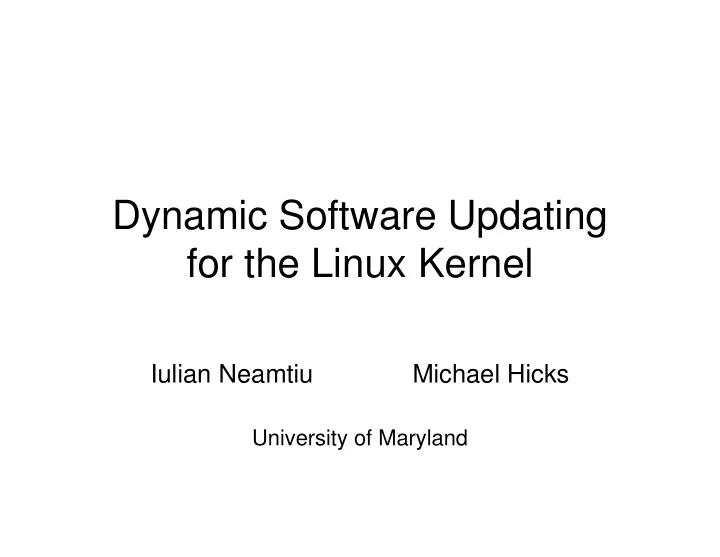

Dynamic Software Updating for the Linux Kernel Iulian Neamtiu Michael Hicks University of Maryland
Why On-the-fly Kernel Updates? • Software updates - necessary evil – Inconvenient, expensive • OS update via stop/restart disruptive – Loss of OS/application state • Dynamic Software Updating (DSU) – User-space programs: easy, safe – Challenge: kernel
DSU for User-space Applications • Ginseng: update C programs while they run [PLDI'06] – Indirect type accesses, function calls – Dynamic patch: new/changed code&data, transformers – Update: load dynamic patch – Safety analyses (type safety) • Results – Off-the-self apps: VsFTPd, OpenSSH, Zebra – 3 years of releases: 2002 - 2005 – Easy to use: minor changes to apps/patches – Good performance: 0..30% overhead – Minimal disruption: < 5 ms
DSU for the Kernel • Safety challenges – Low-level, highly concurrent code � Transactions • Layout & performance constraints � Selective indirection
Better Safety with Transactions • Ginseng enforces representation consistency – Type safety: old code/new data or vice versa • Transactions provide version consistency – Programmer-specified blocks: code/data from same version – Delineate logical events (e.g., ADT, top+bottom half) – No commit, rollback, log – Enforcement: static analyses + light dynamic checks • When is it safe to update ? – Code outside transactions, or – Transaction doesn't conflict with update
Selective Indirection • Performance/representation constraints • Types – Fixed representation/no change expected • E.g., page table entry, IP address – Non-indirected types updated manually • Functions – Indirection/patch size trade-off • Static analysis-driven
Conclusions • Updating the kernel dynamically… – Compile kernel specially (selective indirection) – Automatic patch generation – Safety analyses (version consistency) • …leads to better OS maintenance – Wide range of updates applied on the fly • Security patches, bug fixes, new features – Updates easy to construct, safe to apply http://www.cs.umd.edu/projects/dsu
Recommend
More recommend